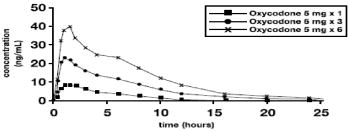Below are the general guidelines for dosing Oxycodone. Note that these dosages may be adjusted on a case-by-case basis for individual patients. Always follow your prescribing physician’s instructions for taking oxycodone.
The following information comes from DailyMed, an FDA label information provider.
What if I miss a dose of Oxycodone?
According to Mayo Clinic, if you miss a dose of Oxycodone you should take it immediately unless you are closer to your next dosing time. If the latter is true, skip the missed dose and take the next dose accordingly. Never double dose.
What if I overdose on Oxycodone?
Clinical Presentation
Acute overdose with oxycodone hydrochloride tablets can be manifested by respiratory depression, somnolence progressing to stupor or coma, skeletal muscle flaccidity, cold and clammy skin, constricted pupils, and in some cases, pulmonary edema, bradycardia, hypotension, partial or complete airway obstruction, atypical snoring, and death. Marked mydriasis rather than miosis may be seen with hypoxia in overdose situations [see CLINICAL PHARMACOLOGY (12.2)].
Treatment of Overdose
In case of overdose, priorities are the re-establishment of a patent and protected airway and institution of assisted or controlled ventilation, if needed. Employ other supportive measures (including oxygen and vasopressors) in the management of circulatory shock and pulmonary edema as indicated. Cardiac arrest or arrhythmias will require advanced life-support techniques.
The opioid antagonists, naloxone or nalmefene, are specific antidotes to respiratory depression resulting from opioid overdose. For clinically significant respiratory or circulatory depression secondary to oxycodone overdose, administer an opioid antagonist. Opioid antagonists should not be administered in the absence of clinically significant respiratory or circulatory depression secondary to oxycodone overdose.
Because the duration of opioid reversal is expected to be less than the duration of action of oxycodone in oxycodone hydrochloride tablets, carefully monitor the patient until spontaneous respiration is reliably reestablished. If the response to an opioid antagonist is suboptimal or only brief in nature, administer additional antagonist as directed by the product’s prescribing information.
In an individual physically dependent on opioids, administration of the recommended usual dosage of the antagonist will precipitate an acute withdrawal syndrome. The severity of the withdrawal symptoms experienced will depend on the degree of physical dependence and the dose of the antagonist administered. If a decision is made to treat serious respiratory depression in the physically dependent patient, administration of the antagonist should be initiated with care and by titration with smaller than usual doses of the antagonist.
Dosage and Administration
Important Dosage and Administration Instructions
Use the lowest effective dosage for the shortest duration consistent with individual patient treatment goals [see WARNINGS AND PRECAUTIONS (5)].
Initiate the dosing regimen for each patient individually, taking into account the patient’s severity of pain, patient response, prior analgesic treatment experience, and risk factors for addiction, abuse, and misuse [see WARNINGS AND PRECAUTIONS (5.1)].
Monitor patients closely for respiratory depression, especially within the first 24 to 72 hours of initiating therapy and following dosage increases with oxycodone hydrochloride tablets and adjust the dosage accordingly [see WARNINGS AND PRECAUTIONS (5.3)].
Initial Dosage
Although it is not possible to list every condition that is important to the selection of the initial dose of oxycodone hydrochloride tablets, attention must be given to:
1. the daily dose, potency and characteristics of a full agonist or mixed agonist/antagonist the patient has been taking previously.
2. the reliability of the relative potency estimate to calculate the dose of oxycodone HCl needed.
3. the degree of opioid tolerance.
4. the general condition and medical status of the patient, including the patient’s weight and age.
5. the balance between pain management and adverse reactions.
6. the type and severity of the patient’s pain.
7. risk factors for abuse or addiction, including a prior history of abuse or addiction.
Use of Oxycodone Hydrochloride Tablets as the First Opioid Analgesic
Initiate treatment with oxycodone hydrochloride tablets in a dosing range of 5 to 15 mg every 4 to 6 hours as needed for pain. Titrate the dose based upon the individual patient’s response to their initial dose of oxycodone hydrochloride tablets. Patients with chronic pain should have their dosage given on an around-the-clock basis to prevent the reoccurrence of pain rather than treating the pain after it has occurred. This dose can then be adjusted to an acceptable level of analgesia taking into account side effects experienced by the patient.
For control of severe chronic pain, oxycodone hydrochloride tablets should be administered on a regularly scheduled basis, every 4 to 6 hours, at the lowest dosage level that will achieve adequate analgesia.
Conversion from Other Opioids to Oxycodone Hydrochloride Tablets
There is inter-patient variability in the potency of opioid drugs and opioid formulations. Therefore, a conservative approach is advised when determining the total daily dosage of oxycodone hydrochloride tablets. It is safer to underestimate a patient’s 24-hour oxycodone hydrochloride tablets dosage than to overestimate the 24-hour oxycodone hydrochloride tablets dosage and manage an adverse reaction due to overdose. If a patient has been receiving opioid-containing medications prior to taking oxycodone hydrochloride tablets, the potency of the prior opioid relative to oxycodone should be factored into the selection of the total daily dose (TDD) of oxycodone.
In converting patients from other opioids to oxycodone hydrochloride tablets close observation and adjustment of dosage based upon the patient’s response to oxycodone hydrochloride tablets is imperative. Administration of supplemental analgesia for breakthrough or incident pain and titration of the total daily dose of oxycodone hydrochloride tablets may be necessary, especially in patients who have disease states that are changing rapidly.
Conversion from Fixed-Ratio Opioid/Acetaminophen, Opioid/Aspirin, or Opioid/Nonsteroidal Combination Drugs
When converting patients from fixed ratio opioid/non-opioid drug regimens a decision should be made whether or not to continue the non-opioid analgesic. If a decision is made to discontinue the use of non-opioid analgesic, it may be necessary to titrate the dose of oxycodone hydrochloride tablets in response to the level of analgesia and adverse effects afforded by the dosing regimen. If the non-opioid regimen is continued as a separate single entity agent, the starting dose oxycodone hydrochloride tablets should be based upon the most recent dose of opioid as a baseline for further titration of oxycodone. Incremental increases should be gauged according to side effects to an acceptable level of analgesia.
Conversion from Oxycodone Hydrochloride Tablets to Extended-Release Oxycodone
The relative bioavailability of oxycodone hydrochloride tablets compared to extended-release oxycodone is unknown, so conversion to extended-release tablets must be accompanied by close observation for signs of excessive sedation and respiratory depression.
Titration and Maintenance of Therapy
Individually titrate oxycodone hydrochloride tablets to a dose that provides adequate analgesia and minimizes adverse reactions. Continually reevaluate patients receiving oxycodone hydrochloride tablets to assess the maintenance of pain control and the relative incidence of adverse reactions, as well as monitoring for the development of addiction, abuse, or misuse [see WARNINGS AND PRECAUTIONS (5.1)]. Frequent communication is important among the prescriber, other members of the healthcare team, the patient, and the caregiver/family during periods of changing analgesic requirements, including initial titration.
If the level of pain increases after dosage stabilization, attempt to identify the source of increased pain before increasing the oxycodone hydrochloride tablets dosage. If unacceptable opioid-related adverse reactions are observed, consider reducing the dosage. Adjust the dosage to obtain an appropriate balance between management of pain and opioid-related adverse reactions.
Safe Reduction or Discontinuation of Oxycodone Hydrochloride Tablets
Do not abruptly discontinue oxycodone hydrochloride tablets in patients who may be physically dependent on opioids. Rapid discontinuation of opioid analgesics in patients who are physically dependent on opioids has resulted in serious withdrawal symptoms, uncontrolled pain, and suicide. Rapid discontinuation has also been associated with attempts to find other sources of opioid analgesics, which may be confused with drug-seeking for abuse. Patients may also attempt to treat their pain or withdrawal symptoms with illicit opioids, such as heroin, and other substances.
When a decision has been made to decrease the dose or discontinue therapy in an opioid-dependent patient taking oxycodone hydrochloride tablets, there are a variety of factors that should be considered, including the dose of oxycodone hydrochloride tablets the patient has been taking, the duration of treatment, the type of pain being treated, and the physical and psychological attributes of the patient. It is important to ensure ongoing care of the patient and to agree on an appropriate tapering schedule and follow-up plan so that patient and provider goals and expectations are clear and realistic. When opioid analgesics are being discontinued due to a suspected substance use disorder, evaluate and treat the patient, or refer for evaluation and treatment of the substance use disorder. Treatment should include evidence-based approaches, such as medication assisted treatment of opioid use disorder. Complex patients with comorbid pain and substance use disorders may benefit from referral to a specialist.
There are no standard opioid tapering schedules that are suitable for all patients. Good clinical practice dictates a patient-specific plan to taper the dose of the opioid gradually. For patients on oxycodone hydrochloride tablets who are physically opioid-dependent, initiate the taper by a small enough increment (e.g., no greater than 10% to 25% of the total daily dose) to avoid withdrawal symptoms, and proceed with dose-lowering at an interval of every 2 to 4 weeks. Patients who have been taking opioids for briefer periods of time may tolerate a more rapid taper.
It may be necessary to provide the patient with lower dosage strengths to accomplish a successful taper. Reassess the patient frequently to manage pain and withdrawal symptoms, should they emerge. Common withdrawal symptoms include restlessness, lacrimation, rhinorrhea, yawning, perspiration, chills, myalgia, and mydriasis. Other signs and symptoms also may develop, including irritability, anxiety, backache, joint pain, weakness, abdominal cramps, insomnia, nausea, anorexia, vomiting, diarrhea, or increased blood pressure, respiratory rate, or heart rate. If withdrawal symptoms arise, it may be necessary to pause the taper for a period of time or raise the dose of the opioid analgesic to the previous dose, and then proceed with a slower taper. In addition, monitor patients for any changes in mood, emergence of suicidal thoughts, or use of other substances. When managing patients taking opioid analgesics, particularly those who have been treated for a long duration and/or with high doses for chronic pain, ensure that a multimodal approach to pain management, including mental health support (if needed), is in place prior to initiating an opioid analgesic taper. A multimodal approach to pain management may optimize the treatment of chronic pain, as well as assist with the successful tapering of the opioid analgesic [see WARNINGS AND PRECAUTIONS (5.13), DRUG ABUSE AND DEPENDENCE (9.3)].
How is Oxycodone supplied?
Oxycodone Hydrochloride Tablet USP are available as follows:
Each Oxycodone Hydrochloride Tablet USP 5 mg is available as a white round convex tablet with a  on one side and “0552” with a vertical bisect between the fives on the other.
on one side and “0552” with a vertical bisect between the fives on the other.
Bottles of 100……………………….. NDC 0406-0552-01
Unit Dose (10 x 10)………………. NDC 0406-0552-62
Each Oxycodone Hydrochloride Tablet USP 15 mg is available as a light green round convex tablet with a  on one side and “15” above a bisect on the other.
on one side and “15” above a bisect on the other.
Bottles of 100……………………….. NDC 0406-8515-01
Unit Dose (10 x 10)………………. NDC 0406-8515-62
Each Oxycodone Hydrochloride Tablet USP 30 mg is available as a light blue round convex tablet with a  on one side and “30” above a bisect on the other.
on one side and “30” above a bisect on the other.
Bottles of 100……………………….. NDC 0406-8530-01
Unit Dose (10 x 10)………………. NDC 0406-8530-62
Dispense in a tight, light-resistant container with child-resistant closure.
Protect from moisture.
Store at 20° to 25°C (68° to 77°F) [see USP Controlled Room Temperature].
Store oxycodone hydrochloride tablets securely and dispose of properly [see PATIENT COUNSELING INFORMATION (17)].
Disclaimer: this article does not constitute or replace medical advice. If you have an emergency or a serious medical question, please contact a medical professional or call 911 immediately. To see our full medical disclaimer, visit our Terms of Use page.





